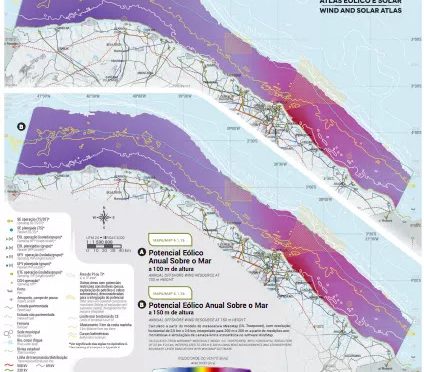A new study has identified a potential of 117 GW of offshore wind power on the Ceará coast for the installation of wind turbines in shallow water offshore wind farms, limited to 24 nautical lines. With a capacity factor of 60% to 62%, it would be possible to generate 506 TWh to 520 TWh per year of wind energy.

Map
of the marine wind energy potential identified by the wind and solar
Atlas of Ceará, segmented by 100 meters (A) and 150 meters (B) high.
The
information comes from the Ceará Wind and Solar Atlas, jointly launched
by the State Development Agency of Ceará (Adece), FIEC and Sebrae, and
prepared by Camargo-Schubert. To incorporate the technical challenge of
installing wind turbines in offshore wind farms away from the coast, the
study did not consider the entire territorial sea of ??the state,
limiting the water depth between 5 meters and 50 meters.
“The
wind farm potential tends to grow dozens of times if the entire economic
and exclusive zone along the coast of Ceará is considered. However,
greater depth, installation, operation and maintenance costs, and
transmission losses would hardly justify the exploitation of the
resource in deeper waters (…) “.
The Atlas highlights the
opportunities on the coast of Camocim, near Sobral, with greater
capacity factor and increase in the afternoon and early evening, on the
coast of Fortaleza, where the Port of Pecém is located, given the
uniform generation during all day, throughout the year, and on the coast
of Icapuí, which borders Rio Grande do Norte, where the capacity factor
is higher in the early hours of the morning and at the end of the
afternoon, with a potential for generation lower near March and April,
when it rains less and the winds are reduced both on the coast and in
the sea.
In fact, from the perspective of the government of
Ceará, the Port of Pecém can become a reference for the offshore wind
farm sector in the country, with the installation of factories for the
construction of wind turbine towers and blades, support bases on the
high seas for boats, boats and ferries for operation and maintenance of
wind farm activities.
The development of wind power projects for
the production of offshore wind energy in Brazil still depends on a
regulatory framework. Ibama prepares a regulatory agenda for such
projects and held a series of workshops to discuss licensing in other
countries in the middle of the year and uses Portugal, Italy, the
Netherlands and Belgium as a reference.
It will also be necessary
to discuss the inclusion of the sector in the planning of supply
expansion to guarantee space for the sector in the National
Interconnected System (SIN) or in the country’s energy distribution
network.
In the Chamber, Senator Fernando Collor (PTC / AL) is in
the process of designing concession auctions for offshore wind farms
and power stations.
The study methodology took into account the
exclusion of the environmental protection area, with submarine cables,
fishing and oil and gas exploration and production concessions.
The
region is limited to 24 nautical miles, bathymetric depths of 5 to 50
meters and beyond 2 km of coastline, considering the effects of the
tides and to avoid erosive processes near the beaches, and the following
assumptions for power generation wind: grid interruptions, turbines and
maintenance (5%), connection point losses (3% to 4.5%), blade
degradation and loss of performance (1.3%)) and aerodynamic losses ( 8%)
In
total, the Atlas indicates an installable potential of 1,635.46 GW,
with photovoltaic, solar thermal and wind energy, being 1,46 GW for
distributed generation in urban regions. It also points to 137 GW of
space for hybrid, solar and wind projects, with a capacity of 315 TWh /
year.
Currently, the state is one of the main renewable energy
markets, with a contracted expansion of 1.1 GW, totaling 2.4 GW of wind
farms and 1.1 GW of solar power plants.
https://www.evwind.com/2019/12/17/ceara-podria-instalar-de-117-gw-de-energia-eolica-marina/


